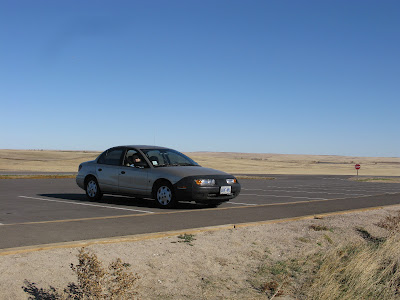Badlands National Park is about 2 hours from our campground. The drive is flat prairie with an occasional hill for variety. Huge prairie dog towns add interest but, don't interact with them. Lots of signs saying "Prairie Dogs have plague". Certainly keeps you from wanting to have them eat out of your hand like we do with chipmunks.
And then suddenly you come upon this wall of sedimentary clay. I always though the badlands was a generic name for desert or poor farming land but its not. Its an actual geological land formation with an obvious start and finish. One minute its flat prairie, the next minute it's this.
There was lots of animal life around so, although the badlands look lifeless apparently there is food for the deer and these mountain sheep.
You can see the prairie in the distance and the badlands where I'm standing. Just below me is the area where Lakota chief Big Foot lead his tribe through the badlands before they were captured and taken to Wounded Knee. More about that later.
This is what the heart of the badlands looks like. Its all sedimentary clay. You can see the layers of sediment that have been deposited over millions of years and is now being gradually washed away. This is expected to be flat prairie in a few million years because there is no rock, just clay.
To show the abrupt nature of the badlands, when I turned around after taking the last picture, this is what I took next. On one side of the badlands the prairie is lower, on the other side the prairie is higher. There are hundreds of feet difference in height between the two prairies.
In the centre of the badlands where a lot of erosion has already taken place, the clay colours are quite vivid in reds and yellows. Desolate but pretty.
About an hour south of the badlands is Wounded Knee, an historical site from the Indian Wars. Lakota chief Big Foot had taken his tribe off the reservation and tried to escape in the badlands but was caught by the US Cavalry and taken to Wounded Knee in December 1890. The soldiers tried to take the weapons from the warriors, a gun went off and when the shooting stopped over 150 Indian men, women and children were dead as well as 25 soldiers. This was the last battle of the Indian wars.
A mass grave was dug and the Indian casualties were buried here. This land is on a reservation and the surrounding area is still used as a cemetery for the natives.
In December 1973, the militant Indian group AIM occupied this area for 71 days. Over 2500 natives resisted demands to leave by over 5000 government agents. By the end, after frequent shots fired back and forth, 2 natives had died, one of which was buried in the Wounded Knee cemetery.










No comments:
Post a Comment